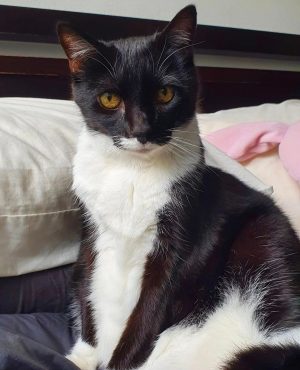Keep your pet comfortable this Winter
By John Morgan | Dated May 12, 2025 | 0 Comments
Can you believe it’s al […]
By John Morgan | Dated July 15, 2022

Beryl is about to start Solensia – a revolutionary new treatment for arthritis in cats
As your cat ages, you may notice that they begin to slow down and spend more time resting. Whilst these changes can be associated with aging (or even the colder weather!), they may be more subtle indicators of osteoarthritis. Osteoarthritis is a degenerative disease of the joints that causes stiffness and soreness in cats, particularly as they become older. It can be difficult to diagnose osteoarthritis as cats are the masters of hiding pain – they are less likely to display the typical signs of arthritis that we expect to see in dogs and even humans such as limping, struggling on walks, and being slow to rise after rest.
Changes associated with osteoarthritis can be subtle. They may include:
A diagnosis may be further confirmed with X-rays, but often lifestyle and behavioural changes alone can make a big difference.
There are several things that you can do to make your pet more comfortable at home:
There are a number of treatment options that can greatly reduce the pain associated with osteoarthritis and improve your cat’s quality of life. These include joint supplement injections (Cartrophen®) that promote the production of healthy joint fluid and cartilage and also help in reducing inflammation. These injections are usually given as 4x weekly injections every 6 months.
Anti-inflammatory painkillers (Meloxicam) may also be prescribed for your cat, particularly if there is significant discomfort present. This is a liquid that you can put in your cat’s food daily. Although this type of medication is often highly effective, there is the risk of undesirable side effects including vomiting and diarrhoea and care does need to be taken in cats with chronic kidney disease. We will often advise that your cat has a blood test before commencing this type of medication.
A new medication that has recently been released for the treatment of feline osteoarthritis in Australia is Solensia®. This medication has been shown to be effective in managing pain associated with osteoarthritis, with the benefit of having lesser undesirable side effects that are sometimes seen with other osteoarthritis medications. It is also safe to use in cats with chronic kidney disease and has the added benefit of being a monthly injection – saving the hassle of daily medication!
This new medication now available at our hospital – please contact us if you would like to learn more!
Written by Victoria Liu, final year veterinary student while on placement at Gordon Vet Hospital.






















